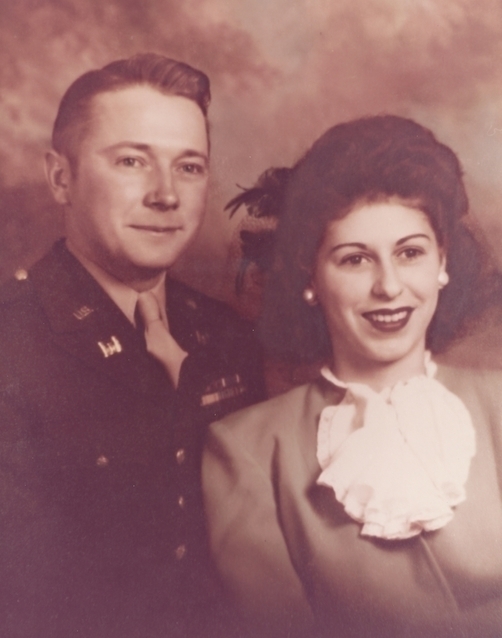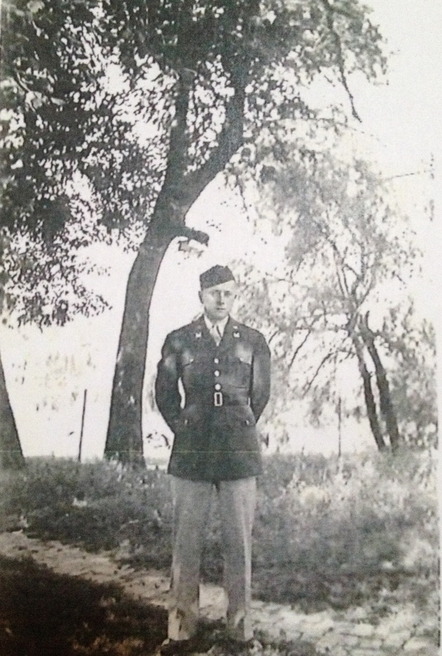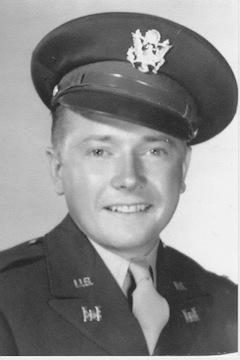Utah Beach, France: Fifth Armored, 237th Battalion, 22nd Armored Engineers (Information extracted from Utah Beach, by Joseph Balkoski)
Lt. Earl E. Luebcke landed on Utah Beach in the second wave. As an engineer, and a demolitions expert, he would be among those responsible for clearing the beach. The result of their effectiveness was that Utah Beach had only 200 casualties.
Aided by the 237th engineers’ hasty construction of a ten yard steel tread-way bridge over a culvert a mile inland, the 4th Division and all its associated vehicles could now flow freely inland. This bridge was built with the helps of Lt. Earl E. Luebcke and that of his men. This was the first of thousands of bridges the U. S. Army would construct in northwest Europe over the next year.
(NOTE: Dad had always told me, Allen, that he had built the first bridge off of Utah Beach. Fifty years later, previously classified documents that I have in my possession have confirmed this to be true.)
The next thing up for the Fifth, and Earl was to trap the German VIIth army in France. On 2 August 1944 the Fifth moved toward closing the Falaise Gap (aka Falaise Pocket). On 8August they would battle to liberate Le Mans, then would proceed to the town of Argentan, France, arriving on 12 August. However, upon their arrival at Argentan, General Montgomery would order them to halt until 14 August. While this action caused the Germans a lot of casualties and a multitude of equipment, Earl and his men did not like it. Later, Earl would say that this was not a good thing, that the men of Fifth Armored thought that they should have closed the gap, thereby trapping the German VIIth army to shorten the war.
On 16 August, the Fifth would move on and take the town of Dreux, then swing north to help in the liberation of Paris, being among the first to the Seine River.
The Fifth would get no rest as they would swing west and spearhead across the rest of France. On 9 September they would free Luxenbourg, afterwards escorting the Prince of Luxembourg into the city.
Earl celebrated his birthday, 11 September 1944, by helping the Fifth cross the Rhine River. For Earl, part of the celebration included being the first Allied forces to cross over into Germany!
Shortly afterwards, Stars and Stripes, an American newspaper that reports on matters affecting the members of the United States Armed Forces, ran an article reporting this monumental event, which was then picked up by U. S. and world news that the Allies had indeed entered Germany. The Fifth Armored Unit had not had any press up to this point. It was know as the Ghost Unit, spearheading the drive across France, often out pacing supplies and running the risk of being cut off from other Allied support. Finally, Allied Command thought that this was too important to not share with the American people.
But there was no rest for the Fifth Armored. After crossing the Rhine River and being the first into Germany, eight days of hard fighting would occur. Their job — to lure the enemy away from the main attack. They did their job well. The Fifth destroyed 44 enemy tanks, inflicted heavy casualties and demolished 103 pillboxes (by 22nd Engineers).
In the previous fifty days of continuous fighting, 7,243 Germans were captured, 4,637 were killed, and 250 tanks were destroyed.
On to Hurtgen
Through Normandy, northern France, a corner of Belgium and the Grand Duchy of Luxembourg, thousands of happy, newly liberated people waved on the 5th Armored Division, called the Victory Division, with the “V” for victory sign.
Yet, all previous battles and experiences would pale in comparison to the fighting and loss of life in the five month carnage in the battle for Hurtgen Forest. With nicknames like Bloody Bucket Ridge, Dead Man’s Moor and Death Valley, this engagement would horrify even veterans of many battles.
Earl was among those wounded in the Hurtgen Forest battle. While leading a recon patrol through the Forest, the shelling and machine gun fire were intense beyond anything they had experienced previously. Earl told his men that they would not live if they returned the way they had come.
In his biography, General Collins, commander of VII Corps, the Aachen-Stolberg-Hurtgen campaign, stated, “The Hurtgen campaign was the toughest, most costly of VII Corp’s operation in Europe.” Following this horrific fighting, with over 24,000 casualties, the 5th Armored moved deeper into Germany.
On to the Elbe
The 5th pushed on to be the first unit to the Elbe River, within 50 miles of Berlin. It was said by Col John T. Cole, Command Co. B, that the engineers were the most versatile troops in the 5th Armored Div. They built bridges, cleared mine fields, maintained roads, demolished pillboxes, provided drinking water, and even fought as infantrymen. Appreciated most by the leading tank platoons was the engineer reconnaissance officer with his expert advice in removal of charges from culverts and bridges and his knowledge of mines and booby traps.
Earl's normal position was behind the fifth tank in the column to support his engineering role. As part of the 22nd Engineers, Earl helped construct a 372 foot tread-way bridge for the XII Corps' assault across the Elbe River on 13 April 1945. It would not be used, however.
The western Allies' decision to leave eastern Germany and the city of Berlin to the Red Army, honoring the agreement they made with the Soviet Union at the Yalta Conference, forced the 5th Armored to halt and advance no further. Berlin fell to the Soviet forces on 2 May 1945.
The End of Fighting
On 16 April 1945, the 5th Armored would be relieved and would await word of action in the Pacific Islands, thus determining where they would be assigned.
Finally, Earl was destined to fight no more but would return to England and board a liberty ship for the long, joyful ride home.
In summary, Earl was among very few soldiers who landed on Normandy Beaches and fought in seven major campaigns, helping to lead the Allied Forces across Europe, into Germany and on to the Elbe. And, most importantly, Lt. Earl E. Luebcke was the only one of nine Combat Armored Engineer recon patrol leaders to bring all of his men home alive.
Many years later, he related the secret of how this was possible. On one early patrol Earl and his unit found a fifty caliber machine gun and mount it on their jeep. When in Germany, the Germans, being in their homeland, would come into town dressed in plain clothes and would wait for Allied patrols. Earl and his men were often behind enemy lines on recon and would stop into local pubs to gather intel. Earl would leave one man on the fifty caliber gun with the following orders, “If we don’t come out, no one comes out.” The German soldiers would see the jeep with the mounted gun and leave them alone.
[Researched and written by Allen Luebcke; edits by Don Luebcke and Joan Palmer.]




